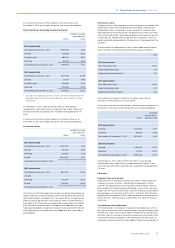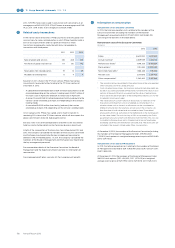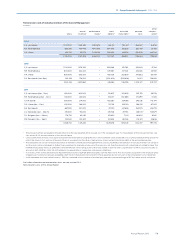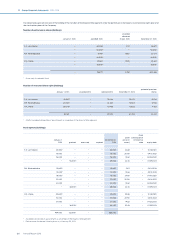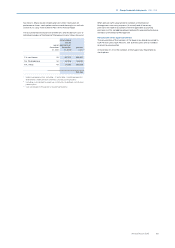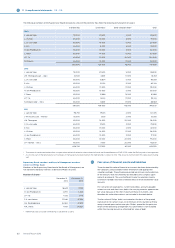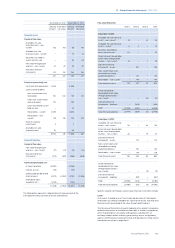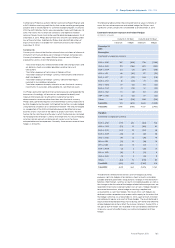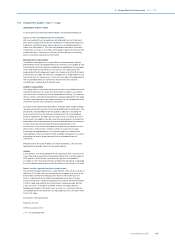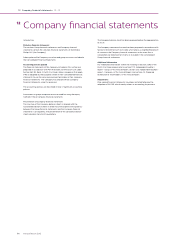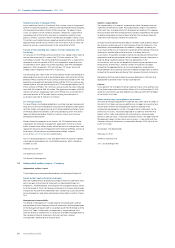Philips 2013 Annual Report Download - page 186
Download and view the complete annual report
Please find page 186 of the 2013 Philips annual report below. You can navigate through the pages in the report by either clicking on the pages listed below, or by using the keyword search tool below to find specific information within the annual report.
11 Group financial statements 11.9 - 11.9
186 Annual Report 2013
The total net fair value of hedges related to transaction exposure as of
December 31, 2013 was an unrealized asset of EUR 44 million. An
instantaneous 10% increase in the value of the euro against all currencies
would lead to a decrease of EUR 68 million in the value of the derivatives;
including a EUR 58 million decrease related to foreign exchange
transactions of the US dollar against the euro, a EUR 15 million decrease
related to foreign exchange transactions of the Japanese yen against
euro, a EUR 15 million decrease related to foreign exchange transactions
of the Pound sterling, partially oset by a EUR 46 million increase related
to foreign exchange transactions of the euro against the US dollar.
The EUR 68 million decrease includes a loss of EUR 19 million that would
impact the income statement, which would largely oset the opposite
revaluation eect on the underlying accounts receivable and payable, and
the remaining loss of EUR 49 million would be recognized in equity to the
extent that the cash flow hedges were eective.
The total net fair value of hedges related to transaction exposure as of
December 31, 2012 was an unrealized asset of EUR 25 million. An
instantaneous 10% increase in the value of the euro against all currencies
would lead to a decrease of EUR 69 million in the value of the derivatives;
including a EUR 96 million decrease related to foreign exchange
transactions of the US dollar against the euro, a EUR 17 million decrease
related to foreign exchange transactions of the Japanese yen against
euro, a EUR 8 million decrease related to foreign exchange transactions of
the Pound sterling, partially oset by a EUR 69 million increase related to
foreign exchange transactions of the euro against the US dollar.
Foreign exchange exposure also arises as a result of inter-company loans
and deposits. Where the Company enters into such arrangements the
financing is generally provided in the functional currency of the subsidiary
entity. The currency of the Company’s external funding and liquid assets is
matched with the required financing of subsidiaries either directly through
external foreign currency loans and deposits, or synthetically by using
foreign exchange derivatives, including cross currency interest rate swaps
and foreign exchange forward contracts. In certain cases where group
companies may also have external foreign currency debt or liquid assets,
these exposures are also hedged through the use of foreign exchange
derivatives. Changes in the fair value of hedges related to this exposure
are either recognized within financial income and expenses in the
statements of income, accounted for as cash flow hedges or where such
loans would be considered part of the net investment in the subsidiary
then net investment hedging would be applied. Translation exposure of
foreign-currency equity invested in consolidated entities may be hedged.
If a hedge is entered into, it is accounted for as a net investment hedge. As
of December 31, 2013 cross currency interest rate swaps and foreign
exchange forward contracts with a fair value liability of EUR 261 million
and external bond funding for a nominal value of USD 4,059 million were
designated as net investment hedges of our financing investments in
foreign operations. During 2013 a total gain of EUR 2 million was
recognized in the income statement as ineectiveness on net investment
hedges. The total net fair value of these financing derivatives as of
December 31, 2013, was a liability of EUR 260 million. An instantaneous
10% increase in the value of the euro against all currencies would lead to
an increase of EUR 245 million in the value of the derivatives, including a
EUR 272 million increase related to the US dollar.
Philips does not currently hedge the foreign exchange exposure arising
from equity interests in non-functional-currency investments in
associates and available-for-sale financial assets.
Interest rate risk
Interest rate risk is the risk that the fair value or future cash flows of a
financial instrument will fluctuate because of changes in market interest
rates. Philips had outstanding debt of EUR 3,901 million, which created an
inherent interest rate risk. Failure to eectively hedge this risk could
negatively impact financial results. At year-end, Philips held EUR 2,465
million in cash and cash equivalents, total long-term debt of EUR 3,309
million and total short-term debt of EUR 592 million. At December 31, 2013,
Philips had a ratio of fixed-rate long-term debt to total outstanding debt
of approximately 80%, compared to 72% one year earlier.
A sensitivity analysis conducted as of January 2014 shows that if long-
term interest rates were to decrease instantaneously by 1% from their level
of December 31, 2013, with all other variables (including foreign exchange
rates) held constant, the fair value of the long-term debt would increase
by approximately EUR 317 million. If there was an increase of 1% in long-
term interest rates, this would reduce the market value of the long-term
debt by approximately EUR 251 million.
If interest rates were to increase instantaneously by 1% from their level of
December 31, 2013, with all other variables held constant, the annualized
net interest expense would decrease by approximately EUR 18 million.
This impact was based on the outstanding net cash position at December
31, 2013.
A sensitivity analysis conducted as of January 2013 shows that if long-
term interest rates were to decrease instantaneously by 1% from their level
of December 31, 2012, with all other variables (including foreign exchange
rates) held constant, the fair value of the long-term debt would increase
by approximately EUR 422 million. If there was an increase of 1% in long-
term interest rates, this would reduce the market value of the long-term
debt by approximately EUR 339 million.
If interest rates were to increase instantaneously by 1% from their level of
December 31, 2012, with all other variables held constant, the annualized
net interest expense would decrease by approximately EUR 25 million.
This impact was based on the outstanding net cash position at December
31, 2012.
Equity price risk
Equity price risk is the risk that the fair value or future cash flows of a
financial instrument will fluctuate because of changes in equity prices.
Philips is a shareholder in several publicly listed companies, including
Chimei Innolux, Shenyang Neusoft Corporation Ltd, and TPV Technology
Ltd. As a result, Philips is exposed to potential financial loss through
movements in their share prices. The aggregate equity price exposure in its
main available-for-sale financial assets amounted to approximately EUR
65 million at year-end 2013 (2012: EUR 120 million including investments in
associates shares that were sold during 2012) and a further EUR 62 million
that has been reclassified as assets held for sale in relation to the agreed
contribution to the Dutch Pension Fund (please refer to note 36,
Subsequent events). Philips does not hold derivatives in its own stock or in
the above-mentioned listed companies. Philips is also a shareholder in
several privately-owned companies amounting to EUR 50 million. As a
result, Philips is exposed to potential value adjustments.
As part of the sale of shares in NXP to Philips Pension Trustees Limited
there was an arrangement that may entitle Philips to a cash payment from
the UK Pension Fund on or after September 7, 2014 if the value of the NXP
shares has increased by this date to a level in excess of a predetermined
threshold, which at the time of the transaction was substantially above the
transaction price, and the UK Pension Fund is in surplus (on the regulatory
funding basis) on September 7, 2014.
Commodity price risk
Commodity price risk is the risk that the fair value or future cash flows of a
financial instrument will fluctuate because of changes in commodity
prices.
Philips is a purchaser of certain base metals, precious metals and energy.
Philips hedges certain commodity price risks using derivative instruments
to minimize significant, unanticipated earnings fluctuations caused by
commodity price volatility. The commodity price derivatives that Philips
enters into are accounted for as cash flow hedges to oset forecasted
purchases. As of December 2013, a loss of EUR 2.2 million was deferred in
equity as a result of these hedges. A 10% increase in the market price of all
commodities as of December 31, 2013 would increase the fair value of the
derivatives by EUR 1.4 million.
As of December 2012, a loss of EUR 0.3 million was deferred in equity as a
result of these hedges. A 10% increase in the market price of all
commodities as of December 31, 2012 would increase the fair value of the
derivatives by EUR 2 million.
Credit risk
Credit risk represents the loss that would be recognized at the reporting
date, if counterparties failed completely to perform their payment
obligations as contracted. Credit risk is present within Philips trade
receivables. To have better insights into the credit exposures, Philips
performs ongoing evaluations of the financial and non-financial condition
of its customers and adjusts credit limits when appropriate. In instances
where the creditworthiness of a customer is determined not to be
sufficient to grant the credit limit required, there are a number of mitigation
tools that can be utilized to close the gap including reducing payment
terms, cash on delivery, pre-payments and pledges on assets.
Philips invests available cash and cash equivalents with various financial
institutions and is exposed to credit risk with these counterparties. Philips
is also exposed to credit risks in the event of non-performance by financial



